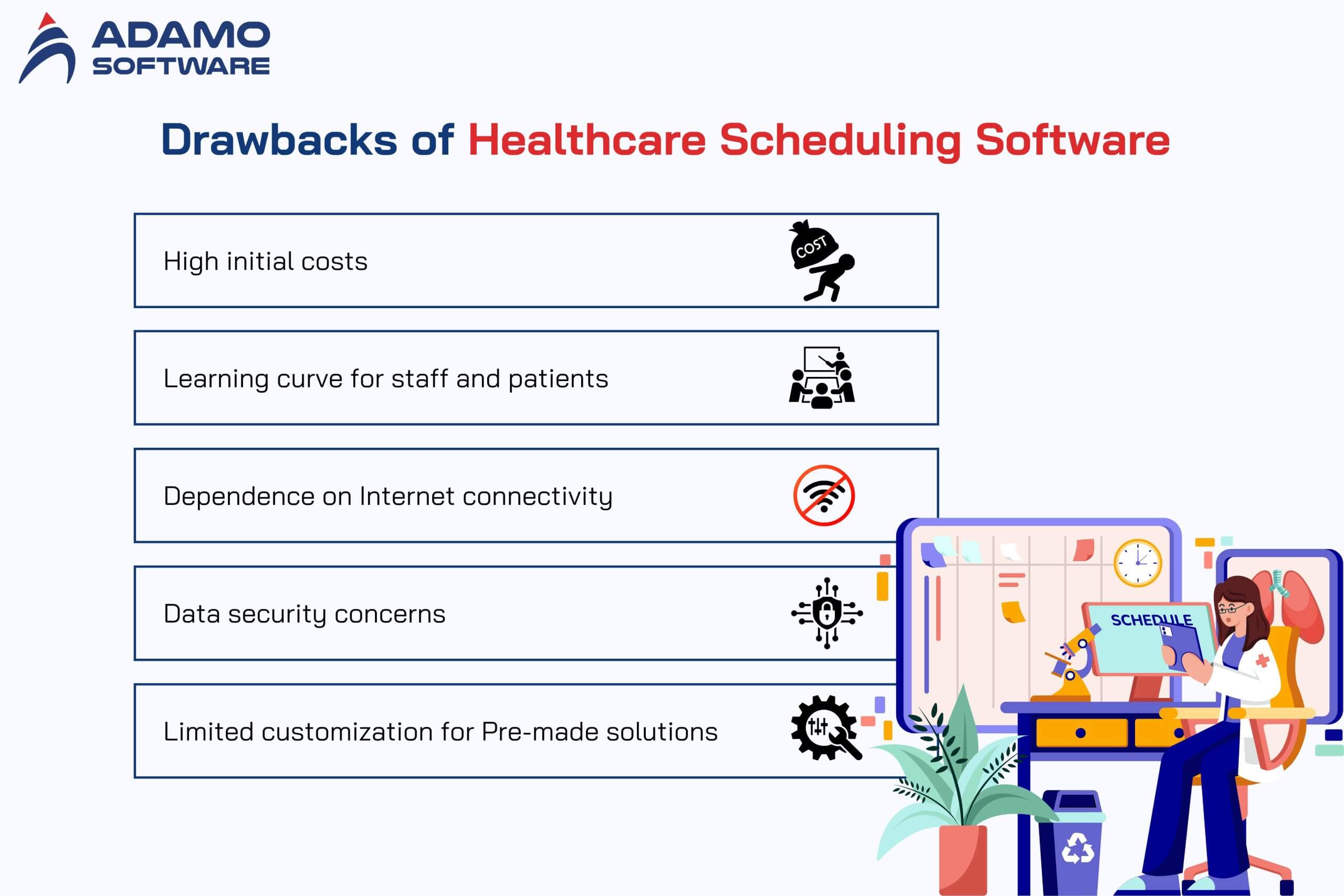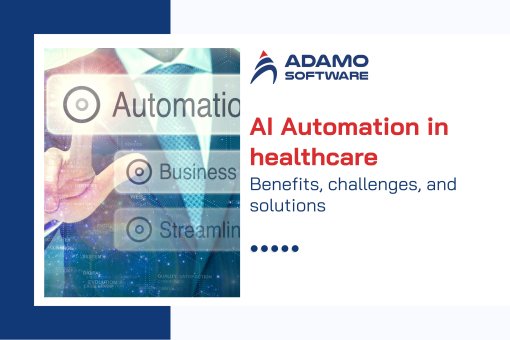Healthcare scheduling software: Definition, Pros, Cons & How to build

Appointment management could not be more crucial in today’s swift-paced healthcare environment as it is through such appointments that critical care is scheduled. Healthcare schedule software is developed to ease and automate the booking, rescheduling, and management of appointments. These functions are from the side of patients for different doctors or other healthcare givers. Healthcare scheduling software helps to avoid scheduling appointments by hand, minimize mistakes, and improve patient interaction. Without fail, this software is the backbone of clinics, hospitals, and private practices. It is responsible for managing appointments and schedules of staff members while ensuring that the patients receive timely attention.
The need for the best schedule has pushed the expansion of healthcare scheduling software in medical practices. Apart from time, it prevents the pressure from coordinating people’s appointments. Privacy features such as automatic alerts, scheduling, and online appointment scheduling enhance the information flow between the patient and caregiver. Healthcare is a dynamic industry, and adopting technologies such as healthcare scheduling software is important to providing patient-centered care.
I. What is healthcare scheduling software?
Healthcare scheduling software is a computer-based program designed to help providers arrange client appointment schedules effectively. It helps to organize appointments for both the patient and the staff. It is for attending the physical or online consultation, rescheduling, and canceling the appointment. Healthcare scheduling software permits the consumer to view true-time availability. The software allows them to schedule appointments quickly.
Healthcare facilities such as clinics and hospitals can cut scheduling issues by applying healthcare scheduling software. Hence, they can save much of their staff’s time and attend to many patients who could be dissatisfied due to long waiting times. Features like reminders, online bookings, and wait lists help patients access healthcare services as easily as the software. Thus, healthcare scheduling software helps manage various healthcare operations radically.
II. Benefits of using scheduling software for healthcare
Scheduling in healthcare benefits in that the use of software has the following benefits that enhance patient care and organization. From streamlining scheduling appointments to reducing the burden some tasks place on healthcare employees, this software makes essential tasks easier. Below are the key benefits of healthcare scheduling software explained in detail:

1. Improved Patient Appointment Management
Consequently, healthcare scheduling software saves time for appointments, rescheduling, or appointment management. Research also shows that 52 percent of medical organizations use 10 hours each week for appointment scheduling. Hospitals and clinics benefit from this because such processes take a lot of time manually. This about-program communicates waitlists and reminds them via a message or an email to the users.
Also, healthcare scheduling software maintains all required patient information in one program. The system helps doctors plan their working days to meet different patient appointments well and effectively. In this respect, patient and staff schedules are as straightforward as possible.
2. Enhanced Staff Efficiency and Productivity
Coping with burnout is critical in the healthcare sector since about 47% of workers experience excessive stress, such as nurses and doctors. The exclusion of phone-based appointments and cancellations is made easier by healthcare scheduling software. Schedules are no longer handled manually, so productivity increases while staff are no longer stressed handling schedules.
Hospitals that implement healthcare scheduling software work in a much better-organized manner, enabling proper management of time. Scheduling appointments can be time-consuming. With the healthcare scheduling software, the staff is left to attend to more important affairs as the software takes time to schedule the appointments.
3. Reduced No-Shows and Cancellations
Failure to attend an appointment is a consideration that is costly to the healthcare providers. The average no-show rate in North America is 27%; as a result, the company loses a lot of money. For instance, a provider who has 20 patients daily in their office, with each patient costing $150 to attend, can lose $750 for the day if all the patients fail to show up. When calculated over this period, the business would be unable to generate $180,000 of its revenue.
Healthcare scheduling software solves this problem by providing automated reminders that cut the no-show rates by 7%. Self-scheduling features also allow patients to cancel or reschedule a doctor’s appointment before or at due time. This ensures the providers can easily cover the gaps, which enhances efficiency and the profits that the providers get.
4. Improvement in Resource Allocation and Management
The healthcare scheduling software provides healthcare givers with holistic information concerning the existing appointments and other assets needed. This makes it easier to manage human resources in terms of staffing and distributing equipment in labs. For instance, if a surgeon is requesting an operating room, the system looks for the available time slot before matching the surgeon to a patient.
Thus, using the software, significant risks of conflicts with schedules are reduced, as the necessary information about staff working hours is given in advance. This helps clinicians and hospitals attain optimal and efficient workings regarding the source establishment.
5. Increased Involvement of Patient
Patients always want something easier for them, and that is exactly what healthcare scheduling software brings to the table. A survey reveals that 68% of the patients are comfortable switching to a new healthcare system that supports self-service scheduling. This feature can enable a patient to make, modify, or even cancel an appointment at any time and without making a phone call.
The efficiency thereby realized allows healthcare scheduling software to improve on the experience of the patient. A similar concept embraced by many patients makes them feel more in charge of their time. Thus, it increases their satisfaction and their interaction with the doctors.
You can explore more about Hospital Management Systems: Types, Key Features & Must-Know Insights here.
III. Drawbacks of healthcare scheduling software
We will explore the advantages and disadvantages of healthcare scheduling software to help providers better understand their options. This may serve as a wake-up call for organizations seeking to embrace this technology. Understanding these challenges will enable them to come up with proper measures to execute this technology.

1. High Initial Costs
Healthcare scheduling software can be costly, particularly for small clinics or patients. The costs of the software, configuration, and interfacing with other relevant applications. These are expenses that may put a deeper hole in organizations with scanty resources to fund their programs.
2. Learning Curve for Staff and Patients
Implementing healthcare scheduling software comes with the need to ensure the staff is trained and this can be time-consuming. There is no doubt that employees have to be trained not to make errors when using the system. Likewise, patients who are not used to using technology devices may find it difficult when applying online booking systems, so this results in confusion.
3. Dependence on Internet Connectivity
Healthcare scheduling software depends heavily on internet connectivity for its proper functioning. Network-related problems can lead to delay or even discontinuity in using the system by the providers and the patients. This has potential problems where there is weak internet connectivity, as is often the case in many parts of the world.
4. Data Security Concerns
Since healthcare scheduling software contains various patient details, it can be considered an asset that needs to be attacked. With inadequate security, there is a high chance that sensitive information belonging to patients will be exposed. The above is a major disadvantage that requires the regular updating of the said program and… sturdy encryption.
5. Limited Customization for Pre-Made Solutions
This means the choice is between using pre-made solutions with insufficient alteration allowed. This is because not all healthcare scheduling software will offer a solution that will fit all organizations. Another disadvantage that can certainly be recognized, is that a set of ready-made solutions does not always contain certain options that are necessary for some providers. Tailoring the software might prove expensive and time-consuming and may not be possible in all healthcare facilities.
However, almost all the problems of healthcare scheduling software are indeed avoidable if appropriate planning, staff training, and stringent security measures are applied.
IV. Essential features of scheduling software for healthcare
Scheduling for healthcare purposes is the tool that is used for the appropriate management of time schedules and medical processes. For this to be possible, certain elements must be developed to comprise the software. The following are the basic parts that determine the efficiency of the healthcare scheduling software for clinics and hospitals.

1. Appointment Booking and Management
The primary role of healthcare scheduling software is therefore to schedule and manage appointments as easily as possible. Availability can be shown in a graphic calendar view so the doctors and administrators can select a working time. On the other hand, patient data is well organized. Some systems also enable patients to fix appointments through the Internet. This allows patients to check the doctor’s calendar and book, reschedule, or cancel an appointment themselves. This saves time, and the outcome increases patient satisfaction.
2. Integration with Electronic Health Records (EHR)
Easily interoperability with the EHR systems is important to support the working processes. It can incorporate the feature of the availability of patient data and records within the healthcare scheduling software. GP no longer has to warp between applications to search for patient information, which has improved the speed of appointment booking.
3. Reminders and Notifications & Exemplifications
This suggestion is to have automated reminders, therefore removing no-shows and other related cases of poor compliance among patients. It is through booking applications; people can be reminded, through emails, text messages, or calls, of their appointments. It can also inform patients who are due for a medication refill or when the next appointment is due. Hence, it improves the communication and service provisions.
4. Multiple logins and User Rights Control
Access rights permit various users, including doctors, nurses, and administrative personnel to get to particular sections of this system. For instance, it can be said that while administrators can set up schedules of appointments, only doctors can validate them. Its purpose in the context of scheduling software for doctors is to provide access to staff only and prevent patient privacy breaches.
5. Reporting and Analytics Abilities
The best healthcare scheduling software has features in reporting and analysis. These tools gather information about common appointments, cancellation rates, and other booking-relevant data. This information is useful for clinics to strategize how they handle their scheduling, and how to become more efficient. For instance, the use of colors in reports can help make a difference and assist in making the right decision.
With these features, there is nothing like healthcare scheduling software for healthcare delivery institutions. It has the potential to increase patient satisfaction, has a positive impact on staff productivity, and provides safe and efficient scheduling of appointments.
V. How to create a custom healthcare scheduling software in 7 steps
In this case, the development of healthcare scheduling software and landscaping needs to address the requirements of both the healthcare service industry and patients. Organization of process guarantees the friendliness of the software, its protection, and its effectiveness to a certain degree. Below are the seven essential steps to develop custom healthcare scheduling software:

1. Identify Your Goals and Requirements
The first step in the process is determining what you expect to be accomplished with your healthcare scheduling software. Take your specific needs in mind. For instance, appointment scheduling enhancement of compatibility with EHRs or reduced no-show frequency. Discuss with the medical practitioners, nurses, and other employees, and then talk to the clients to know their expectations. Lack of communication will be eliminated, and goals formulated will lead to the entire development process.
2. Conduct Market Information and Competitors Analysis
Learn general best practices and known issues with healthcare scheduling software for comparison purposes. Research to establish weak areas within your competitors’ product portfolio to see where you may need to focus on different areas to innovate. This research will assist you in creating outstanding features. These features will set your software apart from others, as they take into consideration the best practices of the software industry.
3. Architecture Design
Draw up a scheme and features of the healthcare scheduling software. This paper will explain what core functions it will have, including appointment booking, timely notification, and multiple-user access. Ensure that the design will complement other systems like EHR. Make your decision between utilizing the cloud or keeping storage in-house depending on the needs of your organization and the requirements that it has.
4. Develop the User Interface (UI)
Convenience is indispensable to the success of your healthcare scheduling software. It is necessary to organize a functional interface that would be convenient for healthcare workers and patients. Facilities that should be incorporated are simple interfaces; well-defined time blocks; and simple, self-serve options to book time and cancel or reschedule appointments. It is necessary to guarantee that it works with the same effectiveness and is very conveniently used on both a laptop and a tablet.
5. Build and Test the Software
Develop software based on architectural and design documents. Program in modern languages and frameworks to guarantee the reliability and scalability of the solution. After the development of the software is over, perform tests on the same rigorously. Scan for any type of bug, any kind of performance problem, or any kind of security flaw. Testing will help your healthcare scheduling software be ready to face the market.
6. Launch and Train Your Staff
After testing, you should use the software in your organization. Conduct awareness-creation sessions to enable the staff to learn how best to utilize the system. Accompany tutorials or user guides for those patients who will be using certain self-service options. Seamless implementation facilitates going to work with the healthcare scheduling software in the right manner.
7. Monitor and Improve the Software
The major task that stakeholders ought to embrace is to monitor and improve the software, as is shown in the following section. However, once the software used in healthcare scheduling is implemented, give it consistent usage checks. Get feedback from the user to know their sentiment to enable the organization to work on the areas of concern. Repair errors, introduce novelties, enhance functionality, or alter priorities depending on the context. Other CMM benefits: continuous improvement can keep your software as efficient and up to date as possible.
If you follow the above steps, you can allow your organization to have well-designed healthcare scheduling software. It can work well in handling your specific challenges and delivering quality patient care.
VI. Why you should partner with Adamo Software for tailored healthcare scheduling software

Currently, there is no ready-made software product that is a perfect fit for every healthcare organization. Therefore, Adamo Software aims to develop a specific product for each customer. We have been working for years on creating the best and most secure scheduling software used in healthcare. We target creating convenient environments that ease scheduling appointments, minimize the rates of non-shown-up patients, and improve patient satisfaction. With Adamo Software, your business will have a scheduling system that meets its needs and requirements.
Working with Adamo Software provides business access to a proficient programming team that will devote efforts to innovation and product quality. We implement advanced digital health technologies to consistently develop effective and efficient healthcare scheduling software compatible with others, such as EHR. You can invent a solution to schedule patients and other staff by contracting the services of professionals in this field.











